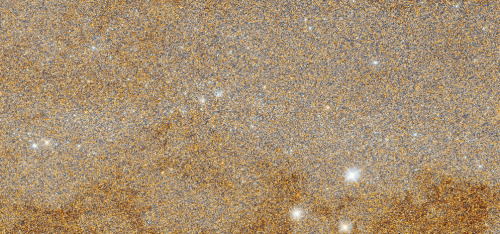Solar Surges Are Cool Jets Of Plasma Ejected In The Solar Atmosphere From Chromospheric Into Coronal

Solar surges are cool jets of plasma ejected in the solar atmosphere from chromospheric into coronal heights. This particular surge has been captured in a loopy structure and streamed sunwards along the magnetic field lines.
Surges are associated with active regions and they are most likely triggered by magnetic reconnection and magnetohydrodynamic (MHD) wave activity. According to their morphological features, surge prominences can be classified into three types: jet-like, diffuse, and closed loop (above). Jet-like and diffuse surges are associated with coronal mass ejections (CMEs), but the closed-loop surges are not because the initial acceleration of the eruption is slowed down and finally stopped by the overlying coronal loops.
Credit: SDO/ LMSAL
More Posts from Littlecadet-biguniverse and Others

M63, Sunflower Galaxy


M7: Open Star Cluster in Scorpius : M7 is one of the most prominent open clusters of stars on the sky. The cluster, dominated by bright blue stars, can be seen with the naked eye in a dark sky in the tail of the constellation of the Scorpion . M7 contains about 100 stars in total, is about 200 million years old, spans 25 light-years across, and lies about 1000 light-years away. The featured wide-angle image was taken near the city of Belo Horizonte in Brazil. The M7 star cluster has been known since ancient times, being noted by Ptolemy in the year 130 AD. Also visible are a dark dust cloud on the lower right, and, in the background, literally millions of unrelated stars towards the Galactic center. via NASA
js

A shot of just a tiny bit of the Andromeda Galaxy, from the sharpest ever view taken by the Hubble Space Telescope
Full size image

Island Point Milky Way
Nikon d5100 - 6 x 25s - ISO 4000 - f2.8 - 16mm

Charon and Pluto: Strikingly Different Worlds
js

Vdb 158 and PLN 110-12.1
Credit: Jimmy Walker
(NASA)
The Juno spacecraft just recorded these creepy sounds around Jupiter
Via Science Alert


Carina Nebula clouds. So stunning.

The California Nebula.
-
 lucid-assemblance reblogged this · 5 years ago
lucid-assemblance reblogged this · 5 years ago -
 nickcaveandthewildgeese liked this · 6 years ago
nickcaveandthewildgeese liked this · 6 years ago -
 swinginnickelthingfriend liked this · 6 years ago
swinginnickelthingfriend liked this · 6 years ago -
 iindigoboii liked this · 6 years ago
iindigoboii liked this · 6 years ago -
 2c-2b-2feel-blog reblogged this · 6 years ago
2c-2b-2feel-blog reblogged this · 6 years ago -
 caesarino-zeppeli liked this · 6 years ago
caesarino-zeppeli liked this · 6 years ago -
 ajc18615425 liked this · 6 years ago
ajc18615425 liked this · 6 years ago -
 altorebel96 reblogged this · 6 years ago
altorebel96 reblogged this · 6 years ago -
 altorebel96 liked this · 6 years ago
altorebel96 liked this · 6 years ago -
 nebulitshop-blog reblogged this · 7 years ago
nebulitshop-blog reblogged this · 7 years ago -
 helloaponyfan liked this · 7 years ago
helloaponyfan liked this · 7 years ago -
 gnosiscollection-blog reblogged this · 8 years ago
gnosiscollection-blog reblogged this · 8 years ago -
 rosst-n-found reblogged this · 8 years ago
rosst-n-found reblogged this · 8 years ago -
 chesterpoindexter liked this · 8 years ago
chesterpoindexter liked this · 8 years ago -
 jupitergalactis reblogged this · 8 years ago
jupitergalactis reblogged this · 8 years ago -
 st3arman-junkie liked this · 8 years ago
st3arman-junkie liked this · 8 years ago -
 cheesewhizexpress reblogged this · 8 years ago
cheesewhizexpress reblogged this · 8 years ago -
 fonte78-blog liked this · 8 years ago
fonte78-blog liked this · 8 years ago -
 clefairyfanaccount liked this · 8 years ago
clefairyfanaccount liked this · 8 years ago -
 pa-pa-plasma liked this · 8 years ago
pa-pa-plasma liked this · 8 years ago -
 bobchik reblogged this · 8 years ago
bobchik reblogged this · 8 years ago -
 bobchik liked this · 8 years ago
bobchik liked this · 8 years ago -
 visionoflovely liked this · 8 years ago
visionoflovely liked this · 8 years ago -
 hawkkn reblogged this · 8 years ago
hawkkn reblogged this · 8 years ago -
 cakeandsodomy22 reblogged this · 8 years ago
cakeandsodomy22 reblogged this · 8 years ago -
 thizzle-dance reblogged this · 8 years ago
thizzle-dance reblogged this · 8 years ago -
 captainrexmanning liked this · 8 years ago
captainrexmanning liked this · 8 years ago -
 mauriceisbored reblogged this · 8 years ago
mauriceisbored reblogged this · 8 years ago -
 mauriceisbored liked this · 8 years ago
mauriceisbored liked this · 8 years ago -
 zeushiroll reblogged this · 8 years ago
zeushiroll reblogged this · 8 years ago -
 doesitseemabsurd reblogged this · 8 years ago
doesitseemabsurd reblogged this · 8 years ago -
 thelustloveworld reblogged this · 8 years ago
thelustloveworld reblogged this · 8 years ago -
 shmackendat-asscid reblogged this · 8 years ago
shmackendat-asscid reblogged this · 8 years ago -
 vongeist liked this · 8 years ago
vongeist liked this · 8 years ago -
 fhz48no-blog liked this · 8 years ago
fhz48no-blog liked this · 8 years ago -
 wakemeupthisafternoon reblogged this · 8 years ago
wakemeupthisafternoon reblogged this · 8 years ago -
 wakemeupthisafternoon liked this · 8 years ago
wakemeupthisafternoon liked this · 8 years ago -
 rexisky liked this · 8 years ago
rexisky liked this · 8 years ago -
 hopenope666-blog liked this · 8 years ago
hopenope666-blog liked this · 8 years ago
GREETINGS FROM EARTH! Welcome to my space blog! Let's explore the stars together!!!
144 posts